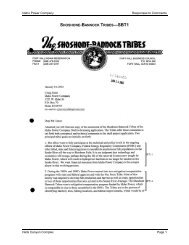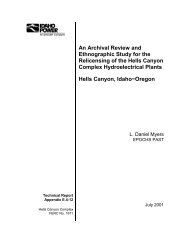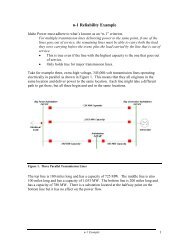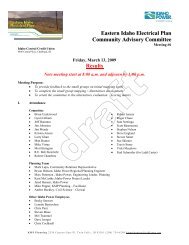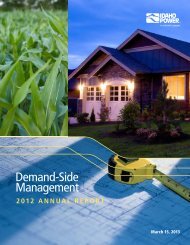Assessment of Chukar and Gray Partridge Populations - Idaho Power
Assessment of Chukar and Gray Partridge Populations - Idaho Power
Assessment of Chukar and Gray Partridge Populations - Idaho Power
- No tags were found...
You also want an ePaper? Increase the reach of your titles
YUMPU automatically turns print PDFs into web optimized ePapers that Google loves.
Hells Canyon <strong>Chukar</strong> <strong>and</strong> <strong>Gray</strong> <strong>Partridge</strong> Report, Ratti <strong>and</strong> Giudice 34relationship between density <strong>and</strong> index values. Early morning call counts for gray partridge maybe an appropriate method <strong>of</strong> monitoring gray partridge in Hells Canyon.4.10. Limiting Factors4.10.1. Weather4.10.1.1. <strong>Chukar</strong>. Environmental conditions, which govern weather <strong>and</strong> foodsupply, play an important part in regulating nesting <strong>and</strong> hatching success <strong>and</strong>, subsequently,annual population density <strong>of</strong> chukars (Christensen 1996). Furthermore, given that basic habitats<strong>of</strong> chukar are found in arid or semi-arid regions, the primary factor influencing reproductivesuccess <strong>and</strong> annual production is the amount <strong>of</strong> precipitation received during key periods <strong>of</strong> theyear (e.g., Walter 2000). The effective precipitation in any given range largely determines thecomposition, abundance, <strong>and</strong> condition <strong>of</strong> essential food plants, which in turn play a major rolein influencing annual production (Christensen 1958, 1970). In Nevada, chukar populationsduring 1951-69 typically exhibited a “boom or bust” pattern that was correlated with droughtconditions <strong>and</strong> the subsequent lack <strong>of</strong> food (Christensen 1970). According to Christensen(1970:45), “when a population bottoms out, it seems to require a minimum <strong>of</strong> three goodproduction years, back to back, to bring the population to a peak again. Such a sequence doesnot usually occur <strong>and</strong> the population may drift along at a mediocre level for several years.”Although no quantitative data are available, comparisons <strong>of</strong> production data with timing <strong>of</strong>precipitation during nesting <strong>and</strong> hatching suggest that unseasonable rains <strong>and</strong> snows cansignificantly lower nest success <strong>and</strong> chick survival (Christensen 1970). Likewise, heavysnowfall in combination with cold temperatures can result in substantial overwinter mortality,especially in areas where elevational movements are restricted (Christensen 1952b). Forexample, Galbreath <strong>and</strong> Morel<strong>and</strong> (1953) estimated 65-75% mortality due to severe winterconditions in Washington during in 1949-50. However, heavy losses from winter storms areusually erratic in nature <strong>and</strong> populations <strong>of</strong>ten recover relatively quickly through immigration<strong>and</strong> the high reproductive potential <strong>of</strong> survivors (Galbreath <strong>and</strong> Morel<strong>and</strong> 1953, Christensen1970).4.10.1.2. <strong>Gray</strong> <strong>Partridge</strong>. Weather has been shown to have strong effects onrecruitment <strong>and</strong> overwinter mortality in Wisconsin (Church 1980), New York (Church <strong>and</strong>Porter 1990a), Montana (Weig<strong>and</strong> 1980), <strong>and</strong> Great Britain (Potts 1986). Severe winter weather,especially deep or crusted snow, has been correlated with increased mortality (Potts 1986, Panek1990). In contrast, weather variables explained little <strong>of</strong> the annual variation in population changeon the Palouse Prairie <strong>of</strong> eastern Washington during 1940-92, but this area is characterized byconsistently dry summers <strong>and</strong> moderate winters (Rotella et al. 1996). Nevertheless, brief intensestorms or depth <strong>and</strong> hardness <strong>of</strong> snow pack could occasionally affect the Palouse Prairiepopulation. There have been no studies on effects <strong>of</strong> weather on populations inhabiting HellsCanyon, but effects <strong>of</strong> drought <strong>and</strong> spring storms are probably similar to that described forchukars (see above). However, gray partridge are able to survive extreme winter temperaturesby roosting in tight groups <strong>and</strong> in deep, s<strong>of</strong>t snow, <strong>and</strong> they can burrow through about 1 m <strong>of</strong> s<strong>of</strong>tsnow to find food (Carroll 1993). Thus, gray partridge may not be as vulnerable to severe winterweather as chukars.



